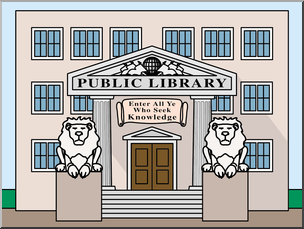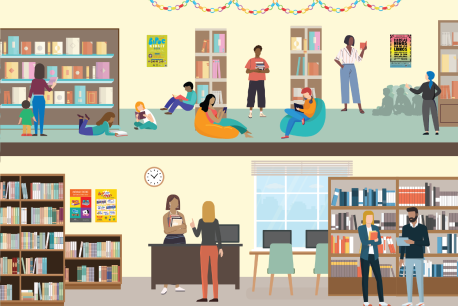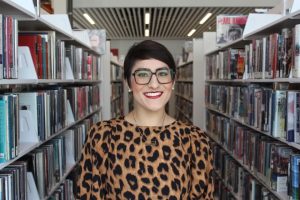Please enjoy my virtual symposium on 5 key takeaways!: https://prezi.com/v/view/XMk8DAfXsfVD6mvbKF0P/
It has been a pleasure to be in this class! I loved every second of it!
Please enjoy my virtual symposium on 5 key takeaways!: https://prezi.com/v/view/XMk8DAfXsfVD6mvbKF0P/
It has been a pleasure to be in this class! I loved every second of it!
For my inspiration report, I selected the infinite learning option and created a learning program for academic libraries. The learning program is about cultural humility and the importance of implementing it in a space such as an academic library in order to cultivate a healthier and more welcoming environment for all.

Through my current position in the library, I have personally witnessed the impact of libraries as classrooms. As someone who creates programming for adults who want to improve their literacy skills, I always strive to make things as fun as possible! At the same time, I want to make sure that my community’s needs are being identified and fulfilled by programs and other offerings. As stated by Dr. Stephens (2014), “as part of our evolution as an educational and teaching space, expanding and updating these offerings for the 21st century is mandatory” (p. 10). One of the most vital and requested programs that I’ve identified is the series of digital literacy workshops. I launched this series of workshops as a result of the community’s needs. Here in Long Beach, California, we are placing effort into addressing digital inequity within our community. “In LA County, it is estimated that approximately 265,000 households do not have a home computer, 311,000 households have access to the internet only through their cellphones, and 416,000 households have no access to the internet at all” (Countywide Communications, 2023). These statistics really motivated me to take action with helping the community and to simultaneously foster an environment for lifelong learning. With technologies constantly advancing, I want to make sure that our community is able to keep up! During these workshops, I bring the participants into a computer lab and I play lo-fi music to set up a tech-savvy/atmospheric mood while I present different technology topics to them. During the presentation, I provide handouts, hands-on practice for them, and fun questions with iconic pop culture characters involved! My goal is for patrons to have fun while learning and retain the information without even realizing it.
As someone who has used libraries my entire life, it is really touching to read about the acknowledgement regarding the impact that libraries have on patrons. Maria Papova (2016) highlights the story of Storm Reyes, a person who was raised in an impoverished Native American community and ultimately became a librarian. This however, would not have occurred if it weren’t for the bookmobile that showed up on the fields of her hometown. This is just one of many stories about how libraries have touched the lives of others–including mine. As I mentioned before in my previous blog post(s), libraries played a fundamental role in my life when my family and I emigrated to the US. Libraries helped me with learning English and now I am a life-long learner thanks to libraries. With that said, part of what I love about my current position in the library is connecting with people and learning about their individual backgrounds. It truly is a learning experience for both parties and I cherish the knowledge that I gain from our patrons in the library while I am building rapport with them. The word ‘humility’ is especially important here because an inclination to learn, maintaining an open mind, and having empathy is what fosters lifelong learning. Additionally, as highlighted by Michael Wheeler, one of the key attributes of cultural humility is acknowledging and balancing the power imbalance between yourself and others. Therefore, I am truly grateful for having the privilege to listen to stories told by others. Stories are powerful. Stories challenge our biases and our comfort zones. One of my favorite Ted Talks is the one conducted by David Mosher and Kimendran Chetty as they end the presentation by stating that they are change. In order to “be the change that one wants to see in the world”, one must adopt a mindset of cultural humility.
Upon exploring the Anythink website, I am very pleased to see the high amount of creativity and passion involved in the remodeling/revamping of Adams County libraries in Colorado. The videos that I have seen so far–although promotional–really cement the idea of focusing entirely on user experience. As stated in Dr. Stephens’ lecture, the design of the Adams County libraries pay tribute to the concept of Hygge. The video that caught my eye the most was the one titled “A Day in the Life of an Anythink Library” because it feels so refreshing to see the library in the perspective of the user–it is welcoming, cozy, and inspiring. Furthermore, Anythink’s staff manifesto is so unique! Although it is very humorous, it simultaneously feels uplifting because it humanizes library staff. “You are not just an employee” really reverberates in my mind because public service staff are subject to so many things ranging from daily interactions to resolving crisis situations. It is important to remember that library staff are human too and their wellbeing matters too. Overall, the practices laid out by Anythink do a great job of uplifting the people–not just the institution. Sure, it’s great to have access to a beautiful building but we should be paying close attention to the people who would be utilizing said building. Lastly, I would like to point out that Anythink’s strategic plan is very admirable because it highlights the power of the people and the manifestation of their learning goals and/or skills. This further exemplifies what is said in the aforementioned video: “We’re not just a public library, we’re YOUR public library”.

Anything Wright Farms interior
The Polyglot Club is an immersive experience for library patrons who are seeking to learn new languages, cultures, and to form new connections. This project would allow the library to directly engage with community members, create a lifelong learning environment, and simultaneously expand their language services. Please enjoy my innovation strategy roadmap!

















Throughout several discussions with academic librarians, I have noticed that library space continues to be a prevalent topic in the field. Whether its about makerspaces, adding VR technology to the library space, or even something as simple as adding new study rooms, more academic librarians are looking for strategies on how best to redesign the library space. This makes me think back to when I was a college student and the types of things that I enjoyed about my library and/or wished I could have experienced. Some frustrations that I remember experiencing were lack of tables and chairs, lack of outlets in some areas, and lack of study room space where one can talk in normal volume. But reimagining a space that would be most comfortable and efficient for students is not an easy task–there are so many factors to consider. In her report, Alison J. Head (2016) highlights how, “Librarians and architects placed importance on what students needed in their libraries. Yet, less than a third of the sample (31%) said they used formal methods to systematically collect user data as part of the planning process” (p.3). This is sadly, not surprising. While I completely understand that academic librarians have good intentions when designing these spaces, it is extremely important to ask the stakeholders themselves (i.e. the students who will be using the space) for feedback before moving forward with projects related to designing/redesigning library space. There are also so many libraries that have already completed similar projects that we can learn from. David Vinson (2020) highlights a couple that contain very unique user spaces; such as the space in Baker-Berry Library that resembles a coffee house. There are so many opportunities for creativity when it comes to designing the library space! This prospect makes me feel very excited about what the future holds for academic libraries. As long as academic librarians remain conscientious about prioritizing user feedback, of course.

Dartmouth College’s Baker-Berry Library
References:
Head, A. (2016, December 6). Planning and Designing Academic Library Learning Spaces: Expert Perspectives of Architects, Librarians, and Library Consultants. Papers.ssrn.com. https://papers.ssrn.com/sol3/papers.cfm?abstract_id=2885471
Vinson, D. (2020, July). Rethinking Campus-Based Library Spaces with Innovative Designs & Furnishings – PUPN. PUPN Magazine; PUPN. https://pupnmag.com/article/rethinking-campus-based-library-spaces-with-innovative-designs-furnishings/
I find myself connecting profoundly with Sammar and Sabrina’s story found in Hasan’s (2023) article on libraries as sanctuaries for health and wellness. As someone whose native tongue is not English, libraries have always provided safety and support for my English learning. Essentially, the library was my safe space growing up; my family did not have many resources upon moving to the US so we relied heavily on free resources like the library. I was able to learn English alongside my parents and I nurtured a profound love for books that continues to this day.  Similarly, libraries serve as a safe space for others–even if for different reasons. I agree with Angela Savage when she states that libraries are a free, non-judgmental space that is accessible to everyone (Hasan, 2023). All people from different backgrounds are welcome into the space where they can freely use library resources, interact with their peers, and/or meet new people. In my current role, I have seen so many friendships flourish–especially between patrons who come in to the library for the sake of socialization and distraction for their minds. This provides a great segue into the idea of a library as community driven. In her article, Pewhairangi implores us to get to know our most valuable library members by not just asking them questions, but getting to know them better as people. In a public library position like the one I currently hold, this is super important. I always catch myself designing library programming based on what I think is best but in those instances, I manage to ask myself: what do the participants want? What do they need? Am I fulfilling their needs?
Similarly, libraries serve as a safe space for others–even if for different reasons. I agree with Angela Savage when she states that libraries are a free, non-judgmental space that is accessible to everyone (Hasan, 2023). All people from different backgrounds are welcome into the space where they can freely use library resources, interact with their peers, and/or meet new people. In my current role, I have seen so many friendships flourish–especially between patrons who come in to the library for the sake of socialization and distraction for their minds. This provides a great segue into the idea of a library as community driven. In her article, Pewhairangi implores us to get to know our most valuable library members by not just asking them questions, but getting to know them better as people. In a public library position like the one I currently hold, this is super important. I always catch myself designing library programming based on what I think is best but in those instances, I manage to ask myself: what do the participants want? What do they need? Am I fulfilling their needs?
I totally agree that we in fact should become obsessed with our most valuable library members. In an ideal world, we would be able to reach every single member of the entire community surrounding our libraries. The good news is that we can start small and grow from there.

References:
https://www.sbs.com.au/language/bangla/en/article/free-nonjudgmental-and-accessible-how-your-local-library-is-a-sanctuary-of-health-and-wellness/t15blzsi9







Hello Everyone!

My name is Michelle and I’m from Long Beach, California! Some of my hobbies include: running, hiking, reading, studying mandarin, and exploring new places! I am also a horror fan (hence the title of my blog) and I love music–my favorite band is Interpol.
I chose this course first and foremost because I love Dr. Stephens’s way of teaching and his support for his students. As soon as I learned about this course, I planned to take it as soon as I could. One of the things that most resonated with me after taking Info 200 with Dr. Stephens is viewing the library as a classroom. Libraries have changed so much throughout the years and something that I am very interested is user experience. I want acclimate to emerging library trends and new technologies that can have a positive impact on learning and/or overall enjoyment of the library space. I’m super excited to dive into these topics and immerse myself into discussions on our positions as information professionals and how we can equip ourselves to improve user experience. Although I am in the academic librarianship pathway, I currently work in a public library and I feel that there is a lot of overlap with regard to library spaces and patron needs! Some of my interests in the LIS world include: instruction, collection development, research, and programming.
Looking forward to blogging with you all!
© 2024 The Morbid Librarian
Theme by Anders Noren — Up ↑